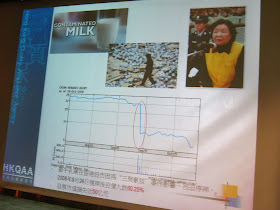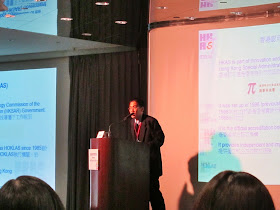In the beginning, Mr. Gregory Leung (Convener, Panel on Promoting Testing and Certification Services in Food Trade, HKCTC) gave a welcoming remarks. He said T&C industry was very important to ensured the food safety.
The first speaker was Dr. Samuel Yeung Tze-kiu (Principal Medical Officer, Risk Assessment & Communication Division, Centre For Food Safety, Food and Environmental Hygiene Department) and his presentation topic was "Legislation and Regulations on Food Safety in Hong Kong".
Dr. Yeung briefed the regulatory framework for food in Hong Kong.
Chapter:132 - PUBLIC HEALTH AND MUNICIPAL SERVICES ORDINANCE
Regulatory control on food additives included Colouring matter, Sweeteners, Preservatives, Food Adulteration, Harmful Substances, Mineral Oil and Pesticide Residues. Then Dr. Yeung mentioned "1+7" Nutrition Labelling Scheme (1.7.2010) and legal microbiological standards included Frozen Confections Regulation (Cap.132AC) and Milk Regulation (Cap.132AQ).
Lastly, Dr. Yeung concluded that testing and certification (T&C) could ensure their products fulfilled the local legal food safety requirement in Food Trade. Moreover, part of food testing from Government Laboratory had been outsourced to the local industry since 2008. It could relieve the workload of Government Laboratory and provide business opportunity to local T&C Industry.
The second speaker was Mr. Simon Wong (Chairman, Hong Kong Food Council; Member, Panel on Promoting Testing and Certification Service in Food Trade, HKCTC) and his presentation was "How Testing and Certification Help Local Food Suppliers and Manufacturers to Ensure Safety and Quality of Food".
The relationship between testing & certification (T&C) and Food Industry was mentioned. The following reasons explained why we needed T&C.
1. Food safety accident - natural or man-made
2. Public health(e.g. Radiation accident to protect incoming food )
3. Quality assurance to Food Industry
4. Export and Import Food importance (i.e. Credibility of T&C system, surveillance, supply chair management and monitoring and established food safety standard)
The third speaker was Mr. Bryan Peng (General Manager, Hong Kong Quality Assurance Agency) and his presentation title named "Food Safety Certification".
In the beginning, Mr. Bryan Peng explained what reason the Food Safety Certification needed. He quoted the milk contaminated case which was serious impacted on the financial result!
Then Mr. Peng used the formula "Profit (P) = Revenue (R) - Cost (C)" to indicate that P decrease, R decrease and C increase if food safety accident happen. The following diagram showed that "Food and Product Safety" was ranked number 2 in the mind of consumer.
After that Mr. Peng introduced the structure of Food Safety Management System that service provided by HKQAA included Hygiene Control System (HCS), Hazard Analysis and Critical Control Points (HACCP) and ISO 22000:2005 Food Safety Management Systems. He said the more practical and easier for beginner was HCS which had six key elements included Management Commitment, Hygiene Operation, Environmental Hygiene, Food Handling, Personal Hygiene, System Monitoring, Control and Certification.
Ms. Kammy Yeung (Sales and Marketing Manager, Hong Kong Standards and Testing Centre) was the fourth speaker and his topic entitled "Food Safety Testing".
Ms. Yeung introduced different food testing included Nutritional Analysis, Food quality and safety. She said food preservatives mainly used for controlling the growth of bacteria and mold that extending the food shelf life but not good for human health if excess. The following diagram showed some commonly used food preservatives included Benzoic acid content, Methyl para-hydroxybenzoate, Ethyl para-hydroxybenzoate, Propyl para-hydroxybenzoate, Nitrate & Nitrite content, Propionic acid, Sorbic acid content and Sulphur dioxide content.
Then she also introduced some not permitted preservatives included Formaldehyde content, Boric acid content, Hydrogen peroxide, Formaldehyd Sodium Sulfoxylate and Salicylic acid. Others were briefed included Antioxidant, Artifical Colouring Matter, Artificial Sweetener, Toxic Contaminants, Heavy Metals (Sb, As, Cd, Cr, Pb, Hg & Sn), Pesticides, Pathogens, etc.
The first Q&A session
I asked how to benefit SME for food testing and certification in terms of cost. Mr. Simon Wong replied it was heavy burden for SME and he suggested if government could support and take initiative such as supporting fund for food safety testing.
After tea break, Dr. Terence Lau (Chief Operating Officer, Hai Kang Life Corporation Limited HK; Member, Panel on Promoting Testing and Certification Services in Food Trade, HKCTC) was the fifth speaker and he presented the topic "An Overview on Molecular Food Testing: Its Principle and Application".
In the beginning, Dr. Lau explained what is molecular testing (Nucleic acid/ DNA testing). Then he introduced Molecular Nucleic Acid Testing (NAT) technology to us included Polymerase Chain Reaction (PCR), NASBA/LAMP, DNA Sequencing and biosensors, etc.
The comparison between traditional culture testing and NAT testing was summarized in the following table. NAT using PCR was much faster than culture method.
At the end, Dr. Lau discussed about genetically modified organism (GMO) / Food and its testing. GMO/Food had three concerns included Health, Trade and Environment.
The sixth speaker was Mr. Jack Lo Tim-lun (Senior Manager, Castco Testing Centre) and his presentation named "Testing for Food Composition and Nutrition Labelling".
Mr. Jack Lo introduced Nutrition Label with 1+7 test that 1 (energy) + 7 (protein, carbohydrate, total fat, sat. fatty acids, trans fatty acids, Na and sugars). The following slide was two methods for the analysis of Energy.
After mentioned different testing methods, Mr. Jack Lo concluded that the testing was very economic for food industry.
The last speaker was Dr. John Ho (Senior Accreditation Officer, HKAS) and his topic named "Accreditation Services for Food Testing and Certification".
Dr. John Ho introduced the history of HKAS and its three schemes included HOKLAS, HKCAS and HKIAS. He stated the HOKLAS endorsed report was recognized by different countries through MRA and MLA.
The second Q&A session
One question asked how DNA testing to separate living and dead organism. Dr. Terence Lau said only living organism was detected RNA but both living and dead organism were detected DNA. Moreover, Dr. Lau said DNA testing could also perform quantitative analysis.
Reference:
HKCTC - http://www.hkctc.gov.hk/en/about.html
HKAS - http://www.itc.gov.hk/en/quality/hkas/about.htm
Regulatory control on food additives included Colouring matter, Sweeteners, Preservatives, Food Adulteration, Harmful Substances, Mineral Oil and Pesticide Residues. Then Dr. Yeung mentioned "1+7" Nutrition Labelling Scheme (1.7.2010) and legal microbiological standards included Frozen Confections Regulation (Cap.132AC) and Milk Regulation (Cap.132AQ).
Lastly, Dr. Yeung concluded that testing and certification (T&C) could ensure their products fulfilled the local legal food safety requirement in Food Trade. Moreover, part of food testing from Government Laboratory had been outsourced to the local industry since 2008. It could relieve the workload of Government Laboratory and provide business opportunity to local T&C Industry.
The second speaker was Mr. Simon Wong (Chairman, Hong Kong Food Council; Member, Panel on Promoting Testing and Certification Service in Food Trade, HKCTC) and his presentation was "How Testing and Certification Help Local Food Suppliers and Manufacturers to Ensure Safety and Quality of Food".
The relationship between testing & certification (T&C) and Food Industry was mentioned. The following reasons explained why we needed T&C.
1. Food safety accident - natural or man-made
2. Public health(e.g. Radiation accident to protect incoming food )
3. Quality assurance to Food Industry
4. Export and Import Food importance (i.e. Credibility of T&C system, surveillance, supply chair management and monitoring and established food safety standard)
The third speaker was Mr. Bryan Peng (General Manager, Hong Kong Quality Assurance Agency) and his presentation title named "Food Safety Certification".
In the beginning, Mr. Bryan Peng explained what reason the Food Safety Certification needed. He quoted the milk contaminated case which was serious impacted on the financial result!
Then Mr. Peng used the formula "Profit (P) = Revenue (R) - Cost (C)" to indicate that P decrease, R decrease and C increase if food safety accident happen. The following diagram showed that "Food and Product Safety" was ranked number 2 in the mind of consumer.
After that Mr. Peng introduced the structure of Food Safety Management System that service provided by HKQAA included Hygiene Control System (HCS), Hazard Analysis and Critical Control Points (HACCP) and ISO 22000:2005 Food Safety Management Systems. He said the more practical and easier for beginner was HCS which had six key elements included Management Commitment, Hygiene Operation, Environmental Hygiene, Food Handling, Personal Hygiene, System Monitoring, Control and Certification.
Ms. Kammy Yeung (Sales and Marketing Manager, Hong Kong Standards and Testing Centre) was the fourth speaker and his topic entitled "Food Safety Testing".
Ms. Yeung introduced different food testing included Nutritional Analysis, Food quality and safety. She said food preservatives mainly used for controlling the growth of bacteria and mold that extending the food shelf life but not good for human health if excess. The following diagram showed some commonly used food preservatives included Benzoic acid content, Methyl para-hydroxybenzoate, Ethyl para-hydroxybenzoate, Propyl para-hydroxybenzoate, Nitrate & Nitrite content, Propionic acid, Sorbic acid content and Sulphur dioxide content.
Then she also introduced some not permitted preservatives included Formaldehyde content, Boric acid content, Hydrogen peroxide, Formaldehyd Sodium Sulfoxylate and Salicylic acid. Others were briefed included Antioxidant, Artifical Colouring Matter, Artificial Sweetener, Toxic Contaminants, Heavy Metals (Sb, As, Cd, Cr, Pb, Hg & Sn), Pesticides, Pathogens, etc.
The first Q&A session
I asked how to benefit SME for food testing and certification in terms of cost. Mr. Simon Wong replied it was heavy burden for SME and he suggested if government could support and take initiative such as supporting fund for food safety testing.
After tea break, Dr. Terence Lau (Chief Operating Officer, Hai Kang Life Corporation Limited HK; Member, Panel on Promoting Testing and Certification Services in Food Trade, HKCTC) was the fifth speaker and he presented the topic "An Overview on Molecular Food Testing: Its Principle and Application".
In the beginning, Dr. Lau explained what is molecular testing (Nucleic acid/ DNA testing). Then he introduced Molecular Nucleic Acid Testing (NAT) technology to us included Polymerase Chain Reaction (PCR), NASBA/LAMP, DNA Sequencing and biosensors, etc.
The comparison between traditional culture testing and NAT testing was summarized in the following table. NAT using PCR was much faster than culture method.
At the end, Dr. Lau discussed about genetically modified organism (GMO) / Food and its testing. GMO/Food had three concerns included Health, Trade and Environment.
The sixth speaker was Mr. Jack Lo Tim-lun (Senior Manager, Castco Testing Centre) and his presentation named "Testing for Food Composition and Nutrition Labelling".
Mr. Jack Lo introduced Nutrition Label with 1+7 test that 1 (energy) + 7 (protein, carbohydrate, total fat, sat. fatty acids, trans fatty acids, Na and sugars). The following slide was two methods for the analysis of Energy.
After mentioned different testing methods, Mr. Jack Lo concluded that the testing was very economic for food industry.
The last speaker was Dr. John Ho (Senior Accreditation Officer, HKAS) and his topic named "Accreditation Services for Food Testing and Certification".
Dr. John Ho introduced the history of HKAS and its three schemes included HOKLAS, HKCAS and HKIAS. He stated the HOKLAS endorsed report was recognized by different countries through MRA and MLA.
The second Q&A session
One question asked how DNA testing to separate living and dead organism. Dr. Terence Lau said only living organism was detected RNA but both living and dead organism were detected DNA. Moreover, Dr. Lau said DNA testing could also perform quantitative analysis.
Reference:
HKCTC - http://www.hkctc.gov.hk/en/about.html
HKAS - http://www.itc.gov.hk/en/quality/hkas/about.htm
























沒有留言:
發佈留言